Home Play: Fun Home Activities for Children for Learning and Enjoyment
Hosted by Dwayne Johnson
Tweet ShareHome Play: Fun Home Activities for Children for Learning and Enjoyment
In today's fast-paced world, finding engaging and educational activities for children at home is essential. These activities not only keep kids entertained but also promote learning and development. This article explores a variety of fun home activities for children that blend enjoyment with educational benefits, catering to different interests and age groups.
1. Arts and Crafts
Arts and crafts are fantastic for nurturing creativity and fine motor skills. Simple projects like painting, drawing, and building models can be both fun and educational. For example, creating a collage using magazine cutouts can teach children about colors, shapes, and textures while allowing them to express their artistic flair. Activities like making homemade playdough or clay sculptures can also introduce basic concepts of chemistry and material properties in an engaging way.
2. Science Experiments
Science experiments at home can spark curiosity and a love for discovery. Simple experiments like making a baking soda and vinegar volcano, creating a homemade lava lamp, or growing crystals can illustrate fundamental scientific principles such as chemical reactions, density, and crystallization. These activities not only entertain but also encourage children to ask questions and think critically about the world around them.
3. Cooking and Baking
Cooking and baking are excellent ways to teach children about measurements, fractions, and following instructions. Involving kids in the kitchen can be both a fun activity and an educational experience. For instance, baking cookies involves measuring ingredients, understanding proportions, and observing how different ingredients react during the baking process. Cooking can also introduce children to different cultures and cuisines, broadening their understanding of global diversity.
4. Reading and Storytelling
Reading and storytelling foster language development, imagination, and empathy. Encouraging children to read a variety of books can enhance their vocabulary and comprehension skills. Storytelling, whether through reading aloud or creating their own stories, helps children develop narrative skills and emotional intelligence. Additionally, engaging in discussions about the stories they read can improve critical thinking and analytical skills.
5. Puzzles and Games
Puzzles and games are great for developing problem-solving skills, logic, and strategic thinking. Jigsaw puzzles, crossword puzzles, and Sudoku are enjoyable ways to challenge children's minds. Board games like chess, Scrabble, and Monopoly teach strategic planning, vocabulary, and basic math skills. These activities also promote patience, concentration, and the ability to work towards a goal.
6. Physical Activities
Physical activities are crucial for children's health and well-being. Indoor games like hide-and-seek, obstacle courses, and dance parties can keep kids active and entertained. Incorporating exercise into daily routines helps develop motor skills, coordination, and overall fitness. Activities like yoga for kids can also teach mindfulness and relaxation techniques, promoting mental well-being alongside physical health.
7. Gardening
Gardening is an excellent way to teach children about nature, biology, and responsibility. Simple projects like planting seeds, caring for a small garden, or growing herbs indoors can introduce concepts like photosynthesis, plant life cycles, and the importance of environmental stewardship. Gardening also provides a hands-on learning experience and a sense of accomplishment as children watch their plants grow.
8. Music and Dance
Music and dance are powerful tools for creative expression and physical activity. Learning to play a musical instrument, singing, or simply enjoying music can enhance auditory skills, rhythm, and coordination. Dance activities not only provide exercise but also encourage creativity and self-expression. Exploring different genres of music and dance styles can also introduce children to various cultures and artistic traditions.
Conclusion
Incorporating these activities into daily routines can significantly enrich children's lives, making learning a joyful and integral part of their development. By blending fun with educational content, parents and caregivers can create a stimulating environment that nurtures curiosity, creativity, and a lifelong love of learning.
Comments
Attendees (1)
Dwayne Johnson Yes
HostPhotos
Kids Learning
